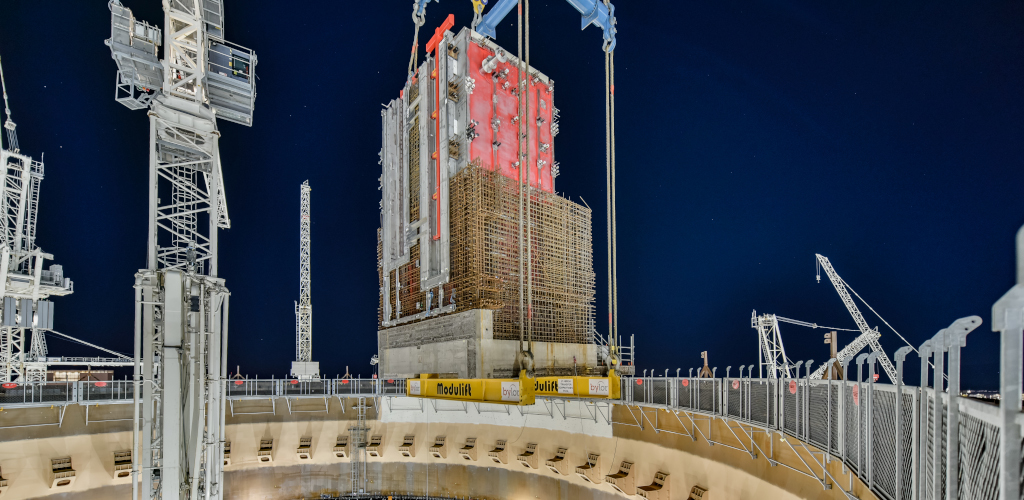Modulift Delivers Speed and Safety at Hinkley Point C

By Malcolm Ramsay
Deploying custom-made, underslung lifting beams, Modulift and Bylor worked together to install a colossal 730-tonne reactor cavity precast pool at the Hinkley Point C nuclear power project in the UK, showcasing precision engineering at its finest.
From Issue 1, 2025 of Breakbulk Magazine.
(5-minute read)
One of the oldest nuclear sites in the UK, Hinkley Point has a long history that stretches back almost 70 years. Over this time, it has seen numerous expansions, often entailing cutting-edge construction techniques, and the latest stage in its development is no different, with the £33 billion Hinkley Point C project.
Developed by EDF, the project marks a significant step toward the UK’s clean energy targets and is slated to begin operations between 2029 and 2031, adding 3.2 gigawatts (GW) of generating capacity, enough to power approximately six million homes.
A key milestone in the construction of this giant complex was the recent delivery and installation of a 730-tonne reactor cavity precast pool, carried out by civil engineering joint venture (JV) Bylor in partnership with specialist lifting equipment manufacturer Modulift.
“The biggest challenge Modulift faced was how soon the custom beams were required for the lift,” Marcos Sanz Gomez, principal engineer and engineering manager at Modulift, commented. “This was to meet a critical project deadline onsite at Hinkley Point C. We overcame this by offering a solution that could be designed and manufactured within the required timescales, but also meet the specific needs of the project.”
Bylor is a JV between French infrastructure firm Bouygues Travaux Publics (TP) and English construction group Laing O’Rourke, and has been contracted for engineering work worth over £2.8 billion at Hinkley Point C.
Steady Progress
Construction first began on Hinkley Point C in 2016, with an area of 430 acres in Somerset in the west of England designated for two pressurized nuclear water reactors, known as EPRs. The base of the first of these was completed in 2019 and work then turned to the construction of the second.
Shortly thereafter, the project faced delays due to the pandemic and restrictions in material availability but, despite these issues, steady progress continued on the site and EDF appointed Bylor as contractor to deliver Hinkley Point C’s main civil engineering works.
A central part of this remit was the installation of the cavity pool, a prefabricated concrete structure designed to house the reactor pressure vessel (RPV) and other essential components of the nuclear reactor. Serving as a containment structure that provides both structural support and safety features, this huge component is essential for the operation of the nuclear reactor, but delivery and installation of this piece presented several challenges.
The sheer size and weight of the unit required precise engineering and logistical planning, from construction in the onsite prefabrication yard at Pool Bunker East, through component assembly and final positioning within the reactor building. The unique nature of the pool meant that every millimeter of movement had to be carefully orchestrated and signed off by a team of construction engineers, lifting specialists and construction methods engineers.
Artur Osicki, temporary works lead at Bylor, told Breakbulk of the complexities involved in the lifting process: “One of the key challenges we faced was the unique geometry of the lifted element. The reactor cavity precast pool is not a standard shape, and its dimensions required meticulous planning to ensure a safe and stable lift.
“Additionally, the number of lifting points had to be carefully calculated to distribute the weight in line with permanent works design assumptions and avoid any potential overstress points.”
The project also had to comply with rigorous UK compliance standards, demanding safety and efficiency at every step.
Selecting the Right Equipment
Bylor began the search for appropriate lifting solutions that would provide suitable levels of control and tolerance. The first step was selecting a crane and for this they turned to Belgian heavy-lift equipment manufacturer and operator Sarens.
Given the size of the project, the team opted to “go big,” selecting the largest lifting capacity on offer, the SGC-250. Known as Big Carl, the SGC-250 is not only Sarens’ largest, but also the second most powerful land-based crane in the world after Mammoet’s SK6000. Launched in 2018, this giant machine is the third generation of the SGC series and has a maximum boom length of nearly 200 meters and a maximum load of 5,000 tonnes.
“Big Carl took on its first assignment at Hinkley Point C [and] has been onsite at the plant since 2019, supporting the construction,” a spokesperson for Sarens said, adding that the crane is commissioned to perform more than 1,000 lifts at the site.
Although this enormous crane provided more than enough lifting power, the intricacies of the move meant that precise control was paramount, and for this Bylor turned to Modulift for a solution.
Headquartered in Poole, England, Modulift has been a leading supplier of high-performance heavy-lifting equipment for over two decades. Founded in 2002 by Sue Spencer, technical director, the firm specializes in modular spreader beams and interchangeable spreader frames, offering an engineering service from initial design concepts to manufacture.
“All lifting equipment is precisely designed using state-of-the-art engineering technology and Finite Element Studies,” Sarah Spivey, managing director at Modulift, explained. “By leveraging our engineering expertise and 20+ years of experience in the nuclear sector, we ensure all lifting equipment adheres to rigorous UK compliance standards such as BS EN.”
Custom Beams
_3.jpg?width=397&height=530) With the specifications for the lift and the installation in hand, Modulift then began the task of designing a suitable solution. The complexity of the reactor cavity precast pool lift required a custom approach, and Modulift’s expertise in designing and manufacturing lifting beams made them the ideal partner.
With the specifications for the lift and the installation in hand, Modulift then began the task of designing a suitable solution. The complexity of the reactor cavity precast pool lift required a custom approach, and Modulift’s expertise in designing and manufacturing lifting beams made them the ideal partner.
“Custom beams were design-engineered by our in-house team and fabricated onsite at our production facility in Poole, Dorset,” Sanz Gomez of Modulift said. “Our in-house engineering team considered the specific requirements and restrictions of the lift and designed a suitable beam to meet these needs.
“In this case, custom underslung beams were used to support the heavy precast pools and designed specifically to suit the reactor’s prefabricated elements, weight and dimensions.”
An underslung lifting beam, also known as an underslung bottom beam or lifting frame, is mounted beneath the load, allowing for more controlled and precise lifting operations. This typically means that it can distribute the weight evenly, minimizing the risk of load shifting during lifting. The placement of attachment points for slings or hooks at each end is also vital to secure the load being lifted.
Close Collaboration
Bylor’s Methods and Temporary Works Design team then collaborated closely with Modulift’s in-house engineering team to provide a series of detailed drawings that included critical dimensions, weights and centers of gravity. Through this process, a comprehensive sequence of operations was defined that integrated Modulift’s custom products into the lifting process.
“The custom design and fabrication process at Modulift includes understanding the customer’s requirements, design-engineering a solution to fit these needs, and then refining the design before it is approved by the customer and moves to the fabrication stage,” Gomez said. “This process was carried out using a controlled and appropriately managed revision and approval system to ensure everything was going to fit and work correctly onsite.”
With the design process complete, fabrication of the beams was carried out at Modulift’s 23,500 square-foot manufacturing facility in the south of England.
“There was one-to-one communication between Modulift and Bylor for technical aspects and the same for commercial,” Osicki said, noting that the beams played “a crucial role in the ongoing construction of Hinkley Point C, supporting the installation of key infrastructure elements.”
The success of this move has seen Modulift expand its involvement at Hinkley Point C, delivering product training for the MEH Alliance Lifting Team, a consortium of contractors covering complex mechanical, electrical, HVAC and associated services across the site.
Osicki added: “Modulift’s reputation for precision engineering and quality assurance provides us with the confidence that all equipment complies with regulations for the UK market. Each custom piece of equipment comes with comprehensive user instructions, ensuring safe and efficient operations on site.”
Future Steps
With the cavity pool securely installed, the project now shifts to the installation of the reactor itself, followed by the monumental task of lifting the 245-tonne steel dome to cap the second reactor building. This dome will not only make the building weatherproof, but also pave the way for mechanical and electrical teams to install critical pipes, equipment and cables.
The 47-meter-wide dome for the first reactor building was successfully installed in December 2023, marking a significant milestone, and, since then, construction on the second reactor unit has accelerated, with teams leveraging lessons from the first unit.
Looking ahead, Osicki said “much like the operations already executed on the UNIT1, the UNIT2 will involve several megalifts, with some even more substantial and challenging due to larger and heavier loads.”
In a notable achievement, in May 2024 the first of Hinkley Point C’s eight 520-tonne steam generators arrived safely at the site after a complex journey by sea and road.
Engineering teams recently completed lifting and placement of the 423-tonne steel liner ring for the second reactor, leaving just the dome to be placed. This lift is scheduled for later this year, bringing the project one step closer to completion.
Modulift, Sarens and Mammoet are regular exhibitors at Breakbulk events. The next event in the calendar is Breakbulk Middle East 2025 on Feb. 10-11 in Dubai.
PHOTO CREDIT: Modulift
